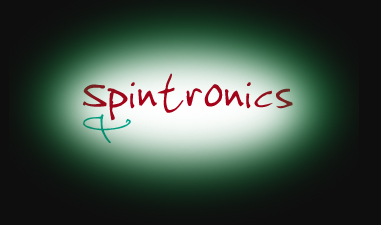Spintronics, sounds like a new dance move for the doof doof crowd but no, Spintronics is a new field of Quantum Physics
that is working towards making the inner workings of computer chips smaller and faster.
Spintronics refers to the science of using the direction of electrons spinning around an atom to store information.
If you could zoom into an atom you would see electrons spinning around a central core - nucleus -, between the circling
electrons and the core is a whole lot of space, even atoms aren't solid. The direction the electrons circle the nucleus - left
or right- is its spin. This spin is the main characteristic that scientists are trying to work with in order to make a whole
new kind of gadget. By being able to alter the direction of the spin and then read it back at any time scientists will be
able store information by using lots of atoms.
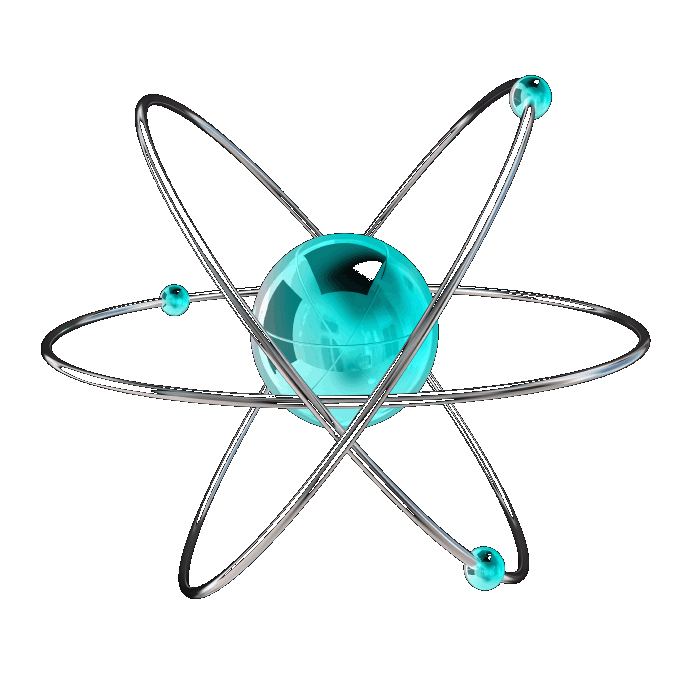 How do you store information using left and right? As long as there are two answers possible, a yes or no, up or down,
left or right, a computer can use it to store data. This is done using binary conversions to convert a normal number into a
longer series of 1's and zero's. So in Spintronics case first left or right
is converted into 1 or 0. By lining 8 atoms up
next to each other and using them together you are able to store a number 0 to 256. Binary works just the same as the
base 10 maths - decimal - everyone is used to. In base 10 when you write a
three digit number the left column is 100's, the middle column is 10's and the right is units - 100, 10, 1. Using three
digits the normal base 10 system can store up to 999 - 9 hundreds, 9 10's and 9 units.
How do you store information using left and right? As long as there are two answers possible, a yes or no, up or down,
left or right, a computer can use it to store data. This is done using binary conversions to convert a normal number into a
longer series of 1's and zero's. So in Spintronics case first left or right
is converted into 1 or 0. By lining 8 atoms up
next to each other and using them together you are able to store a number 0 to 256. Binary works just the same as the
base 10 maths - decimal - everyone is used to. In base 10 when you write a
three digit number the left column is 100's, the middle column is 10's and the right is units - 100, 10, 1. Using three
digits the normal base 10 system can store up to 999 - 9 hundreds, 9 10's and 9 units.
Binary is just the same, a 2 base number with three digits will only
store 0-8. In binary 111 = 7, - 1 in 4 column, 1 in 2 column, 1 in the units column, add the columns up and that's the number
in decimal. Add columns and your can store a bigger number. Using 8 columns - bits - you can build a number up to 256, the columns are
128, 64, 32, 16, 8, 4, 2, 1.
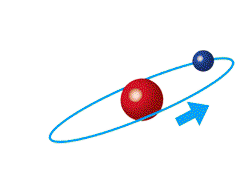
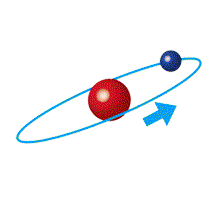 The figure on the right pictures the down-spin (left) and up-spin (right) of an electron - L = angular momentum. S = electron spin momentum.
The figure on the right pictures the down-spin (left) and up-spin (right) of an electron - L = angular momentum. S = electron spin momentum.
Besides having a cool name Spintronics really rocks as it means scientists are developing the tools to work at levels we
hadn't imagined a little while ago. These tools will become the basis of new science and technology. The theories behind
Quantum science have been with us for a while but Spintronics is the most useful and practical application of what was just
a theory up until recently.
Let's begin with the question, "What is special about electron spin?" From a scientific and technological point of view,
there are four important points. First is the connection between spin and magnetism, which is useful for information storage.
Second is an intrinsic connection between spin and quantum mechanics, which may be useful for quantum information.
Third is the short range of spin-dependent exchange interactions, which implies that the role of spin will continue to grow
as the size of nanostructures continues to shrink. Fourth are the issues of speed and power dissipation, which are becoming
increasingly important for electronics at the nanoscale.
First, spin is connected to ferromagnetic materials because the spontaneous magnetisation breaks time-reversal symmetry,
which allows the electronic states within the material to become spin-dependent. This contrasts with non-magnetic materials
where time-reversal symmetry forces the electronic states to come in pairs with the same energy but opposite spin, thus
leading to a density of states that must be independent of spin. In the ferromagnetic metal, the density of states (DOS)
is different for the two spin states. It is conventional to refer to the majority spin as "spin up" while the minority spin
is "spin down." Because most transport properties depend on the density of states near the Fermi level, the spin asymmetry
in the density of states allows ferromagnets to generate, manipulate, and detect spin.
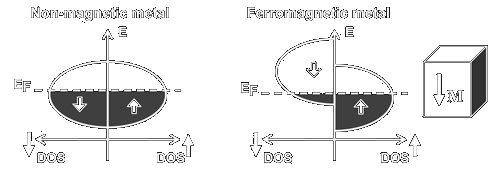 Ferromagnetic materials also possess the property of hysteresis, where the magnetisation can have two (or more) different
stable states in zero magnetic field. The bistability is due to a property called magnetic anisotropy, where the energy of a
system depends on the direction of the magnetisation. There is a preferred axis ("easy axis") with stable states for
magnetisation direction along Φ = 90░ and
Φ = 270░. When a large magnetic field (H) is applied along an easy axis,
the magnetisation (M) will align with this field in order to lower the Zeeman energy, EZeeman=-M-H.
When the magnetic field is turned off, the magnetisation will ideally maintain all of its high-field magnetisation.
A magnetic field applied in the opposite direction will cause the magnetisation to reverse after the field crosses a value
known as the "coercivity" or "coercive field", which depends on the height of the magnetic anisotropy energy barrier.
This magnetic anisotropy generally depends on both the material and its shape. In terms of information storage applications,
the two stable magnetic states in zero magnetic field correspond to the logical "0" and "1" of a data bit. The data can be
written by applying a magnetic field larger than the coercivity to align the magnetisation along the field. Due to the
anisotropy energy barriers, this state is stable even when the magnetic field is turned off. This property makes ferromagnets
natural candidates for information storage. Thus, the connection between spin and ferromagnetism establishes a natural
connection between spintronics and information storage applications.
Ferromagnetic materials also possess the property of hysteresis, where the magnetisation can have two (or more) different
stable states in zero magnetic field. The bistability is due to a property called magnetic anisotropy, where the energy of a
system depends on the direction of the magnetisation. There is a preferred axis ("easy axis") with stable states for
magnetisation direction along Φ = 90░ and
Φ = 270░. When a large magnetic field (H) is applied along an easy axis,
the magnetisation (M) will align with this field in order to lower the Zeeman energy, EZeeman=-M-H.
When the magnetic field is turned off, the magnetisation will ideally maintain all of its high-field magnetisation.
A magnetic field applied in the opposite direction will cause the magnetisation to reverse after the field crosses a value
known as the "coercivity" or "coercive field", which depends on the height of the magnetic anisotropy energy barrier.
This magnetic anisotropy generally depends on both the material and its shape. In terms of information storage applications,
the two stable magnetic states in zero magnetic field correspond to the logical "0" and "1" of a data bit. The data can be
written by applying a magnetic field larger than the coercivity to align the magnetisation along the field. Due to the
anisotropy energy barriers, this state is stable even when the magnetic field is turned off. This property makes ferromagnets
natural candidates for information storage. Thus, the connection between spin and ferromagnetism establishes a natural
connection between spintronics and information storage applications.
 Second, spin is connected to quantum mechanics. In classical mechanics, the angular momentum (i.e. rotational motion) can be
divided into two parts, an "orbital" angular momentum (L) and a "spin" angular momentum (S). If one considers the motion of
the earth, the elliptical motion of the earth around the sun generates orbital angular momentum, while the rotation of the
earth about its axis generates spin angular momentum. For elementary particles such as the electron, the physics is governed
by quantum mechanics. In an atom, the motion of the electron around the nucleus generates orbital angular momentum.
The electron also has spin angular momentum, but it is NOT due to a spinningŁ motion of the electron.
(OK, in a dinner conversation you can describe spin as the spinning motion of an object, but technically this is wrong.)
Second, spin is connected to quantum mechanics. In classical mechanics, the angular momentum (i.e. rotational motion) can be
divided into two parts, an "orbital" angular momentum (L) and a "spin" angular momentum (S). If one considers the motion of
the earth, the elliptical motion of the earth around the sun generates orbital angular momentum, while the rotation of the
earth about its axis generates spin angular momentum. For elementary particles such as the electron, the physics is governed
by quantum mechanics. In an atom, the motion of the electron around the nucleus generates orbital angular momentum.
The electron also has spin angular momentum, but it is NOT due to a spinningŁ motion of the electron.
(OK, in a dinner conversation you can describe spin as the spinning motion of an object, but technically this is wrong.)
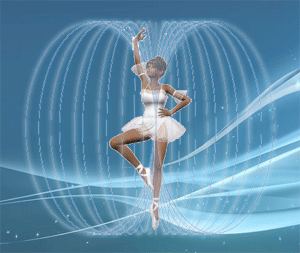 Instead, spin comes out of quantum mechanics when you try to combine it with special relativity, as Dirac did in the 1920's.
In solving the Dirac equation, one of the consequences is the requirement of an internal property that is now known as spin.
Because of its intrinsically quantum mechanical origin, it should be of little surprise that the electron spin has very
unusual properties. For example, its value along any particular axis (say, the z-axis) can only take on two values:
Sz = +ŋ/2 and -ŋ/2. In other notations, these are called "spin up" and "spin down", | ↑ ⟩
and | ↓ ⟩ or | ms = +½ ⟩ and | ms= -½ ⟩.
Instead, spin comes out of quantum mechanics when you try to combine it with special relativity, as Dirac did in the 1920's.
In solving the Dirac equation, one of the consequences is the requirement of an internal property that is now known as spin.
Because of its intrinsically quantum mechanical origin, it should be of little surprise that the electron spin has very
unusual properties. For example, its value along any particular axis (say, the z-axis) can only take on two values:
Sz = +ŋ/2 and -ŋ/2. In other notations, these are called "spin up" and "spin down", | ↑ ⟩
and | ↓ ⟩ or | ms = +½ ⟩ and | ms= -½ ⟩.
It also obeys a Heisenberg uncertainty principle where the three components of spin (Sx, Sy and Sz) cannot be measured
simultaneously. Most importantly from the point of view of computing applications, the spin can be in a quantum superposition
state, such as A | ↑ ⟩ + B | ↓ ⟩, where the coefficients A and B are complex numbers. If you think about digital
electronics as being built on bits that can have two states "0" or "1", you can think about spin as a "quantum bit" which can
be in states |↑⟩, |↓⟩, or in a superposition state A|↑⟩ + B|↓⟩, where |A|2
is the probability of finding the spin in the |↑⟩ state and |B|2 is the probability of finding the
spin in the |↓⟩ state.
The quantum bit, or "qubit", lies at the heart of a new type of proposed computer known
as a quantum computer which could in principle perform some tasks such as factorising numbers or performing searches much
more efficiently than normal digital computers. There are many schemes proposed for quantum computing (with most of them being
unrelated to electron spin) but there is a debate about whether a scalable quantum computer will ever be realised.
Nonetheless, it is a worthy pursuit that pushes the boundaries of our knowledge and technical capabilities, since electron
spin presents the opportunity to exploit quantum mechanical behavior in solids in a manner that is generally inaccessible
in purely charge-based electronics.
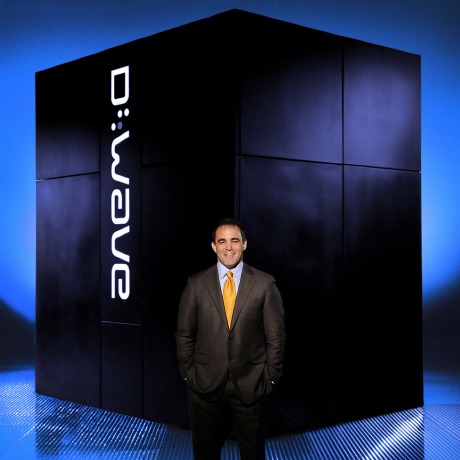 It is this special relation between spin and quantum mechanics which forms a natural
connection between spintronics and advanced computing, whether the goal is a full-blown quantum computer or a more modest
form of quantum information processing that has yet to be devised.
On the right you see the first quantum computer which was sold from the Canadian start-up D-Wave Systems to Lockheed Martin for a reported $10 million in May 2011. It is this special relation between spin and quantum mechanics which forms a natural
connection between spintronics and advanced computing, whether the goal is a full-blown quantum computer or a more modest
form of quantum information processing that has yet to be devised.
On the right you see the first quantum computer which was sold from the Canadian start-up D-Wave Systems to Lockheed Martin for a reported $10 million in May 2011.
Third, the length scale of spin-dependent exchange interactions is on the order of a few atomic spacings. Because of this,
the spin-dependent properties in solids are very sensitive to the atomic scale structure. With the ability to engineer
interfaces at the atomic level by growth techniques such as molecular beam epitaxy (MBE), and with the ongoing improvements
in the fabrication of smaller and smaller structures in the lateral dimensions, the role of spin is likely to become even more
important as nanoscale science continues to advance. Understanding how spin and magnetism depend on the atomic scale interface
and material structure will be an important area of investigation for the development of spintronics.
Finally, spintronics has the possibility to deliver high speed performance and low power consumption, although one should be
cautious about making such blanket statements. As electronic devices continue to shrink in size, one of the biggest problems
is power dissipation and thermal management of circuits. Spin does have some potential benefits in terms of power.
In terms of memory, a ferromagnetic bit can store information without any power consumption to maintain the data due to the
anisotropy energy barrier (in contrast to some semiconductor memories such as SRAM or DRAM). In terms of switching,
while power is required to generate electrical currents to produce magnetic fields or spin torque, precessional dynamics can
ideally proceed without dissipation (although in practice there is always at least a small amount of damping).
In the case of magnetisation switching by spin torque, this creates a counter-intuitive situation where the critical current
required for switching a bit can be lowered by decreasing the damping parameter (e.g. through materials engineering) without
decreasing the anisotropy energy barrier which stabilises the bit. More generally, novel spintronic memory or logic
architectures developed in the future may be able to take advantage of precessional dynamics (of magnetisation or
non-equilibrium spin populations) for low power operation. These are in principle quite advantageous, but in reality a full
power analysis needs to be performed because these energy savings could be more than offset by other required operations
(e.g. generating magnetic field pulses, charging up gates, etc.). Spin also has some potential benefits for speed.
In charge-based electronics, the speed is set by the RC time constants. In utilising spin, it may be possible to circumvent
this general rule. For example, the precession of spin or magnetism (which can be at high GHz frequencies) is not governed
by RC time constants. To sum up, there is potential for high speed, low power applications, but novel circuit architectures
need to be developed to bring this to fruition.
Spintronics is still in it's infancy, experiments are being done and results collected. There are still a lot of things that
need to be worked out, hurdles to overcome but after-all that is what people do well, keep overcoming hurdles, working
through problems. Keep an eye out for the future there are lots of twists to come.
|
